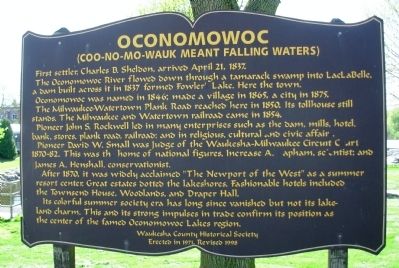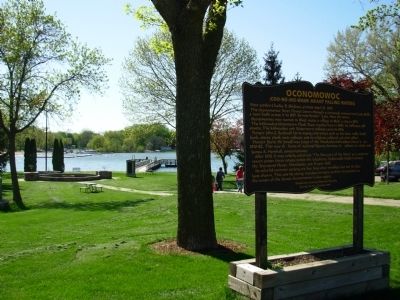Oconomowoc in Waukesha County, Wisconsin — The American Midwest (Great Lakes)
Oconomowoc
(Coo-no-mo-wauk meant Falling Waters)
The Oconomowoc River flowed down through a tamarack swamp into Lac LaBelle, a dam built across it in 1837 formed Fowler's Lake. Here the town.
Oconomowoc was named in 1846; made a village in 1865, a city in 1875.
The Milwaukee-Watertown Plank Road reached here in 1850. Its tollhouse still stands. The Milwaukee and Watertown Railroad came in 1854.
Pioneer John S. Rockwell led in many enterprises such as the dam, mills, hotel, bank, stores, plank road, railroad; and in religious, cultural and civic affairs.
Pioneer David W. Small was Judge of the Waukesha-Milwaukee Circuit Court 1870-82. This was the home of national figures, Increase A. Lapham, scientist; and James A Henshall, conservationist.
After 1870, it was widely acclaimed “The Newport of the West” as a summer resort center. Great estates dotted the lakeshores. Fashionable hotels included the Townsend House, Woodlands, and Draper Hall.
Its colorful summer society era has long since vanished but not its lake-land charm. This and its strong impulses in trade confirm its position as the center of the famed Oconomowoc Lakes region.
Erected 1971 by Waukesha County Historical Society. (Marker Number 24-01.)
Topics. This historical marker is listed in this topic list: Settlements & Settlers. A significant historical date for this entry is April 21, 1932.
Location. Marker has been reported missing. It was located near 43° 6.762′ N, 88° 29.98′ W. Marker was in Oconomowoc, Wisconsin, in Waukesha County. Marker was on North Lake Road (State Highway 67) 0.1 miles north of Wisconsin Avenue (State Highway 16), on the left when traveling north. North Lake Road is also known as North Main Street. Touch for map. Marker was in this post office area: Oconomowoc WI 53066, United States of America. Touch for directions.
Other nearby markers. At least 8 other markers are within 6 miles of this location, measured as the crow flies. The Inn at Pine Terrace (approx. 0.6 miles away); Historic Okauchee (approx. 3 miles away); Highway Marking (approx. 4.2 miles away); Nashotah Mission (approx. 4.2 miles away); Stone Bank (approx. 5 miles away); Bishop Jackson Kemper Home Built 1849 (approx. 5 miles away); Cushing Memorial Park (approx. 5.6 miles away); Wm. R. Look Log Cabin (approx. 5.7 miles away).
Regarding Oconomowoc. Pronounced OH-con-oh-mo-walk
Also see . . . City of Oconomowoc History. (Submitted on May 20, 2011, by Bernard Fisher of Richmond, Virginia.)
Additional commentary.
1. Additional history
Oconomowoc, meaning "Falling Waters," is a picturesque city nestled between two lakes, Fowler and LaBelle, about 31 miles from Milwaukee.
In 1837 a man by the name of Charles Sheldon came to the area. No other white person lived here at that time, but there were some Native Americans. He decided to be the first to stake a claim on a piece of land. He didn't build on it but sold it to Philo Bremer who did build a home. The first business built was a dam and sawmill on the Oconomowoc River between the lakes. Two years later, the dam broke and all was flooded with water. All in all there were four sawmills built there over the years. As more people began to come, many stores and shops were built to accommodate the growing population.
John Rockwell was instrumental in helping the town to grow by building the Oconomowoc, Mayville and Fond du Lac Plank Road in 1850 and convincing the railroad to build here in 1853. The railroad company wanted to build the rails south of Ocomomowoc originally.
In the 1870s multi-millionaires from Chicago, Milwaukee, St. Louis and New Orleans, decided they wanted a place to relax in the summer. Every spring they moved with large staff and servants to resorts or large mansions they built on the lakes. Visitors knew it as the Newport of the West. Mail boats delivered mail to all these new homes. Sometimes people arrived in town in a private railroad car. The summer visitors held lots of dinners, house parties and balls. Draper Hall was the finest hotel in the Midwest at this time.
By World War I the carefree time of recreation for the wealthy was over. The estates remained for some time after that. Oconomowoc became a city in 1875.
— Submitted May 25, 2012, by Linda Hansen of Waukesha, Wisconsin.
2. Marker has been removed.
This marker was taken down by the city in order to erect a veteran’s memorial park.
— Submitted July 9, 2020, by Linda Hansen of Waukesha, Wisconsin.
Credits. This page was last revised on July 10, 2020. It was originally submitted on May 19, 2011, by Paul Fehrenbach of Germantown, Wisconsin. This page has been viewed 1,571 times since then and 58 times this year. Photos: 1, 2. submitted on May 19, 2011, by Paul Fehrenbach of Germantown, Wisconsin. • Bernard Fisher was the editor who published this page.

